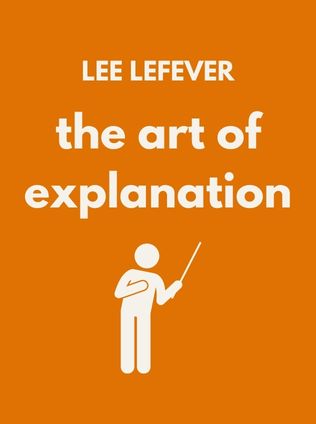
The Art of Explanation
Making Your Ideas, Products, and Services Easier to Understand
By Lee LeFever
Published 10/2012
About the Author
Lee LeFever is the chief explainer, illustrator, and voice of Common Craft LLC, a company renowned for making complex ideas easy to understand through short videos. Since 2007, Common Craft has won numerous awards and created explanations for some of the world's most respected brands, including Intel, Google, Dropbox, and Ford Motor Co. LeFever is widely credited for inspiring the video explanation industry. His mission is to make the world more understandable by equipping professionals with the skills to become explanation specialists.
Main Idea
The Art of Explanation: Making Your Ideas, Products, and Services Easier to Understand by Lee LeFever addresses the crucial need for effective explanations in business and education. LeFever provides tools, tactics, and techniques to help individuals and organizations improve their explanation skills. By mastering the art of explanation, readers can inspire audiences and make their ideas, products, and services more accessible and compelling.
Table of Contents
- Introduction
- Explanation Basics
- Why Explanations Fail
- Planning Your Explanations
- Packaging Ideas
- Context
- Story
- Connections
- Descriptions
- Simplification
- Constraints
- Preparing and Writing an Explanation
- Presenting Explanations
- Visuals
- Explanation Culture
- Your Life as an Explainer
Introduction
LeFever begins by highlighting the importance of effective explanations. Many great ideas and products fail to reach their potential because they are not well explained. Explanation is an essential skill that can be learned and mastered to make ideas come to life and inspire others. The book aims to teach readers how to create explanations that are clear, compelling, and memorable.
"A great explanation can make our ideas come to life, invite people to care, and be motivated to learn more." - Lee LeFever
Explanation Basics
Explanation is the act of making something known, plain, or understandable. It involves empathy, the ability to understand and share the feelings of another. Great explanations help people see ideas from a new perspective and make facts more understandable.
"Explanations present an idea in a way that makes people care." - Lee LeFever
explanation basics:
- Stepping out of your own shoes and into the audience's perspective
- Using empathy to connect with the audience
- Creating explanations that are unique and novel
Why Explanations Fail
Explanations often fail because of the "curse of knowledge," where experts struggle to see from the perspective of novices. Additionally, knowing too little about a subject can lead to poor explanations. Successful explanations require a balance of sufficient knowledge and the ability to empathize with the audience.
"The curse of knowledge is an underlying cause of numerous problems in explanations." - Lee LeFever
why explanations fail:
- Making poor assumptions about what the audience already knows
- Failing to gauge the audience's confidence level accurately
- Approaching explanations without sufficient understanding
Planning Your Explanations
Effective explanations require careful planning. LeFever introduces the "explanation scale," a model that helps explainers visualize the audience's understanding and plan explanations accordingly. The goal is to move the audience from less understanding (Point A) to more understanding (Point Z).
"A great idea poorly explained ceases to appear great." - Lee LeFever
planning explanations:
Sign up for FREE and get access to 1,400+ books summaries.
You May Also Like
The Subtle Art of Not Giving a F*ck
A Counterintuitive Approach to Living a Good Life
By Mark MansonRich Dad Poor Dad
What the Rich Teach Their Kids About Money - That the Poor and Middle Class Do Not!
By Robert T. KiyosakiHow To Win Friends and Influence People
The All-Time Classic Manual Of People Skills
By Dale CarnegieQuiet: The Power of Introverts
The Power of Introverts in a World That Can't Stop Talking
By Susan Cain



















